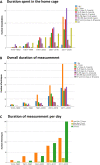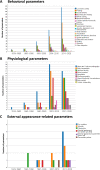A systematic review of the development and application of home cage monitoring in laboratory mice and rats
- PMID: 37953247
- PMCID: PMC10642068
- DOI: 10.1186/s12915-023-01751-7
A systematic review of the development and application of home cage monitoring in laboratory mice and rats
Abstract
Background: Traditionally, in biomedical animal research, laboratory rodents are individually examined in test apparatuses outside of their home cages at selected time points. However, the outcome of such tests can be influenced by various factors and valuable information may be missed when the animals are only monitored for short periods. These issues can be overcome by longitudinally monitoring mice and rats in their home cages. To shed light on the development of home cage monitoring (HCM) and the current state-of-the-art, a systematic review was carried out on 521 publications retrieved through PubMed and Web of Science.
Results: Both the absolute (~ × 26) and relative (~ × 7) number of HCM-related publications increased from 1974 to 2020. There was a clear bias towards males and individually housed animals, but during the past decade (2011-2020), an increasing number of studies used both sexes and group housing. In most studies, animals were kept for short (up to 4 weeks) time periods in the HCM systems; intermediate time periods (4-12 weeks) increased in frequency in the years between 2011 and 2020. Before the 2000s, HCM techniques were predominantly applied for less than 12 h, while 24-h measurements have been more frequent since the 2000s. The systematic review demonstrated that manual monitoring is decreasing in relation to automatic techniques but still relevant. Until (and including) the 1990s, most techniques were applied manually but have been progressively replaced by automation since the 2000s. Independent of the year of publication, the main behavioral parameters measured were locomotor activity, feeding, and social behaviors; the main physiological parameters were heart rate and electrocardiography. External appearance-related parameters were rarely examined in the home cages. Due to technological progress and application of artificial intelligence, more refined and detailed behavioral parameters have been investigated in the home cage more recently.
Conclusions: Over the period covered in this study, techniques for HCM of mice and rats have improved considerably. This development is ongoing and further progress as well as validation of HCM systems will extend the applications to allow for continuous, longitudinal, non-invasive monitoring of an increasing range of parameters in group-housed small rodents in their home cages.
Keywords: Animal welfare; Behavior; History; Home cage monitoring; Mice; Physiology; Rats; Refinement; Rodents; Sex bias.
© 2023. The Author(s).
Conflict of interest statement
The authors declare that they have no competing interests.
Figures








References
-
- Crawley JN. What's wrong with my mouse?: behavioral phenotyping of transgenic and knockout mice. 2. Hoboken, New Jersey: John Wiley & Sons; 2007.
Publication types
MeSH terms
Grants and funding
- EXC 2002/1 "Science of Intelligence" - project number 390523135/Deutsche Forschungsgemeinschaft
- EXC 2002/1 "Science of Intelligence" - project number 390523135/Deutsche Forschungsgemeinschaft
- EXC 2002/1 "Science of Intelligence" - project number 390523135/Deutsche Forschungsgemeinschaft
- EXC 2002/1 "Science of Intelligence" - project number 390523135/Deutsche Forschungsgemeinschaft
- EXC 2002/1 "Science of Intelligence" - project number 390523135/Deutsche Forschungsgemeinschaft
LinkOut - more resources
Full Text Sources
Miscellaneous

